Despite strong rhetoric from policymakers and candidates about the importance of a high-quality education for all children, deep disparities persist in educational opportunities for Michigan children based on income, race and geography. The lack of equity in education has wide repercussions for Michigan’s economy and next generation.
Educational disparities do not occur in a vacuum and can be traced to public policies that limit employment and housing options for many parents, place children in schools without the resources to meet their needs, and often create insurmountable barriers to the American dream of a better life for our children and grandchildren.
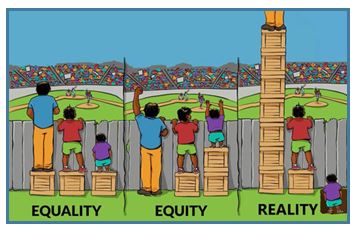
Why Equity Matters
There is a common misconception that educational policies leading to greater racial equity are the same as those that increase equality. These terms cannot be used interchangeably. To create equity, it is necessary to provide the additional resources needed to overcome the consistent, institutional barriers that children of color have faced in Michigan’s educational pipeline. For example, providing the same per-pupil funding to all schools across the state would increase equality in educational financing, but would not create equity by helping children overcome accumulated obstacles that have resulted in an achievement gap. To achieve equity, state funding must fully recognize the higher costs associated with educating children in high-poverty schools.
Diversity in Michigan’s Public Schools
- Total students: In the 2015-16 school year, there were 1,540,005 students in Michigan schools. Of those, 46% were economically disadvantaged.1

- Students of color much more likely to be economically disadvantaged. African-American students in Michigan are twice as likely to be economically disadvantaged than their White peers, with 3 of every 4 African-American students living in families with low incomes or other risk factors.
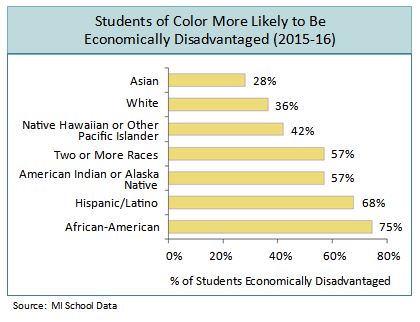
- The teachers in Michigan public schools are less diverse than the student body. While only 67% of the student body are White, 91% of the teachers were White. By contrast, African-American students represented 18% of all students, but only 6% of the state’s teaching staff is African-American.
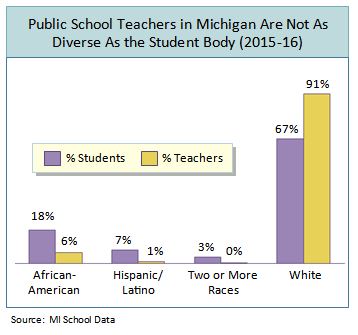
The Barriers to Equity in Education
Children who are low income and children of color face a range of barriers to educational opportunity and achievement.
- Lack of economic and educational opportunities for parents. The League supports a two-generation approach to strengthening families and creating greater opportunity. Research shows a link between maternal education and outcomes for children, and given the relationship between poverty and school achievement, the state must simultaneously focus on educational supports to parents andtheir children.
In Michigan, Latino and African-American parents are much more likely to lack a high school diploma, dramatically limiting their job opportunities, income and housing choices. The problems many struggling families face have been shown to be related to school achievement including homelessness or poor housing, chronic health conditions, unsafe neighborhoods or schools, exposure to environmental toxins, lack of access to healthy food, as well as parents’ own struggles with literacy, stress and related mental health issues.
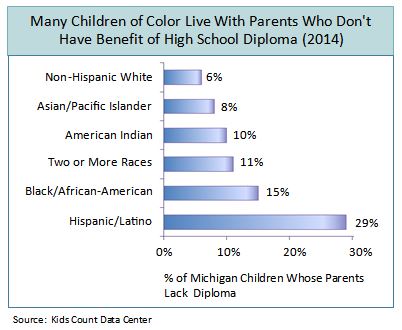
Particularly startling is research showing that the conditions of poverty during the earliest years of life can actually disturb children’s brain development in ways that account for up to 20% of the achievement gap between children from high- and low-income families. Sadly, that gap in brain development continues into adulthood.2
Parents with low incomes are more likely to encounter housing problems and their children are more likely to have to change schools mid-year—disrupting their educations. Housing problems are very common for families with low incomes, and many cannot find an affordable home for their children.
The result can be multiple moves for children, some of which disrupt school attendance. Overall, 9% of economically disadvantaged students changed schools during the 2014-15 school year in Michigan. A closer look at race and ethnicity shows that more than 1 in 10 African-American students changed schools, compared to only 4% of White students. Frequent moves can disrupt children’s achievement.
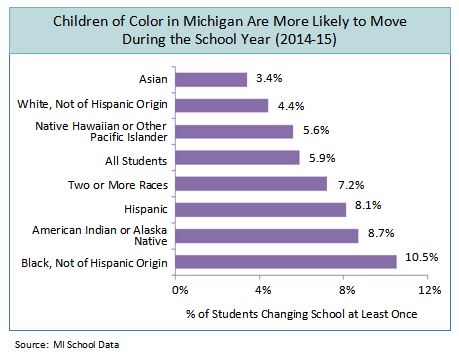
- Budget and public policies that don’t adequately address the costs associated with educating children in high-poverty schools. Students in schools with high numbers of children living with families with low incomes (receiving federal Title I services for disadvantaged youths) are 45% more likely to not be reading proficiently by fourth grade. The relationship between poverty and educational achievement is clear, yet funding for high-poverty schools is falling short in Michigan. Because of historical and systemic discrimination over many years, disproportionate numbers of children of color live in high-poverty neighborhoods where schools are struggling and closing.
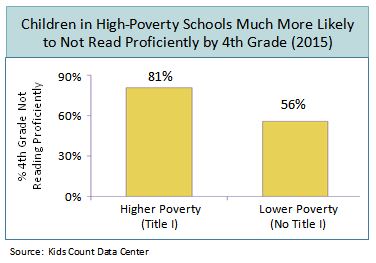
Michigan’s At-Risk School Aid program was established to help school districts address the extra costs associated with educating children in high-poverty neighborhoods and schools. Funds are provided to districts based on the number of children receiving free schools meals (130% of poverty or about $26,000 for a family of three). Sadly, the At-Risk program has only been fully funded for two years since it was created in 1995, and is currently approximately $135 million below the level needed to meet the formula set in law. The cumulative shortfall in At-Risk funding stands at $2 billion.
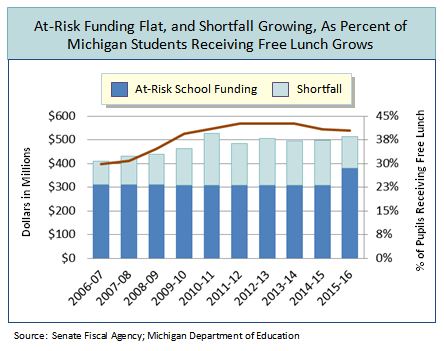
- Inequitable discipline practices. In addition to the higher rate of suspensions, African-American and American Indian students in the state are more than twice as likely to be expelled from school. Disparities in suspensions begin early. Nationwide, Black preschool children are 3.6 times as likely to receive one or more out-of-school suspensions as White preschool children.
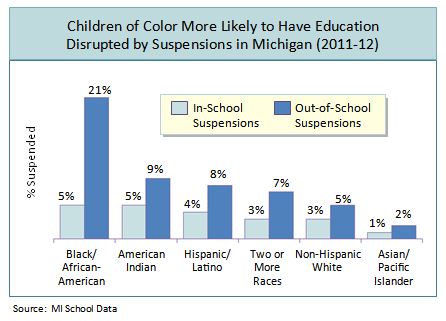 Preschool expulsion has been identified as a problem by the Michigan Department of Education, which is now developing proposed guidelines for early childhood educators.3 Also moving forward in the state Legislature are bills to address Michigan’s tough zero tolerance disciplinary laws and policies, and promote restorative practices that give children a second chance.
Preschool expulsion has been identified as a problem by the Michigan Department of Education, which is now developing proposed guidelines for early childhood educators.3 Also moving forward in the state Legislature are bills to address Michigan’s tough zero tolerance disciplinary laws and policies, and promote restorative practices that give children a second chance.
The Consequences of Cumulative Educational Inequities
-
-
- Differences in achievement are evident by fourth grade. Eight of 10 African-American students and two-thirds of Latino children are not proficient in English/Language Arts by the end of third grade based on the state’s M-STEP test.
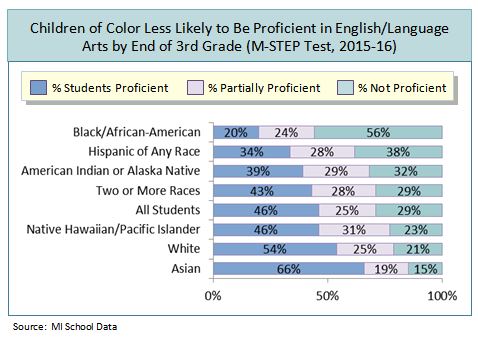
- Fewer children of color are completing high school on time, cutting short their chances of a higher education or a job leading to economic opportunities. In the 2014-15 school year, the high school dropout rate for African-American, Hispanic and Native American youths was more than twice the rate for White students.
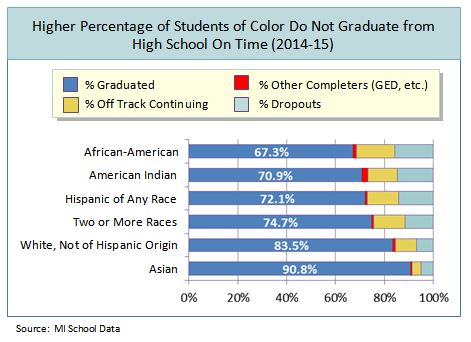
- Fewer youths of color are college-ready. Based on SAT test scores, only 1 in 10 African-American high school students in Michigan were college ready in 2015-16, compared to 4 of every 10 White students.
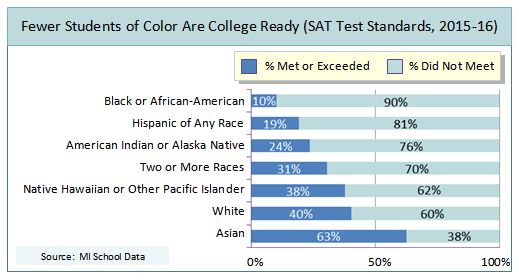
- Having faced inequities from the earliest years, fewer young adults of color in Michigan are able to access the higher education needed to succeed. Approximately one-third of African-American young adults in Michigan are in college or have completed college, compared to more than half of White adults ages 18-24.
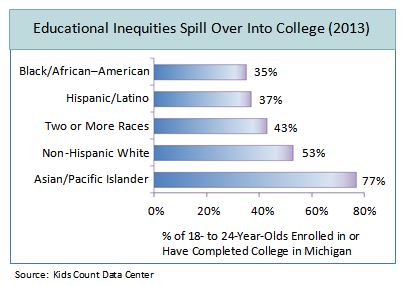
- Lower levels of employment and earnings. Higher dropout rates and less access to a college degree have potentially lifelong repercussions for families of color. In Michigan, the median earnings of adults (25 years and over) with less than a high school degree is approximately $18,000, compared to more than $31,000 for those with some college or an associate degree and nearly $49,000 for those with a bachelor’s degree.4
-
Policies Needed to Promote Equity in Education in Michigan
It has been well documented that one of the leading contributors to economic opportunity and security is access to a high-quality education from cradle to career. As Michigan becomes more diverse, it will not succeed in creating a competitive educational system or economy if all children don’t have the opportunity to succeed. Michigan policymakers have the opportunity to make Michigan a leader through strategic investments that create educational equity.
-
-
- Create a two-generation educational agenda that addresses literacy levels and educational achievement for parents and their children, including access to post-secondary education for parents through adequate means-tested financial aid, access to high-quality child care, early literacy supports for children to improve reading by third grade, and services to improve parent literacy skills.
- Fully fund the state’s At-Risk School Aid program and provide other funds needed to improve high-poverty schools and serve students who have faced racial and economic barriers to success.
- Invest in the earliest years of life, including access to affordable, high-quality child care services and early education, early intervention services such as Early On, and programs to address young children’s social and emotional growth and development.
- Adopt and enforce school disciplinary policies that reduce inequities in suspensions and expulsions, including policies for preschool-age children and restorative justice practices.
-
Endnotes
-
-
- Students are economically disadvantaged if they are determined eligible for free or reduced-price meals (185% poverty), are in households receiving food or cash assistance, are homeless, migrant or in foster care.
- Kwon, D., “Poverty Disturbs Children’s Brain Development and Academic Performance,” Scientific American (July 22, 2015).
- Key Highlights on Equity and Opportunity Gaps in Our Nation’s Public Schools, 2013-2014 Civil Rights Data Collection, U.S. Department of Education Office for Civil Rights (June 7, 2016).
- Median Earnings in the Past 12 Months (in 2014 inflation-adjusted dollars) by Sex by Educational Attainment for the Population 25 Years and Over, 2010-2014 American Community Survey 5-Year Estimates, U.S. Census Bureau.
-
[types field=’download-link’ target=’_blank’][/types]




 Emily Jorgensen joined the Michigan League for Public Policy in July 2019. She deeply cares about the well-being of individuals and families and has a great love for Michigan. She is grateful that her position at the League enables her to combine these passions and work to help promote policies that will lead to better opportunities and security for all Michiganders.
Emily Jorgensen joined the Michigan League for Public Policy in July 2019. She deeply cares about the well-being of individuals and families and has a great love for Michigan. She is grateful that her position at the League enables her to combine these passions and work to help promote policies that will lead to better opportunities and security for all Michiganders. Jacob Kaplan
Jacob Kaplan 


 Mikell Frey is a communications professional with a passion for using the art of storytelling to positively impact lives. She strongly believes that positive social change can be inspired by the sharing of data-driven information coupled with the unique perspectives of people from all walks of life across Michigan, especially those who have faced extraordinary barriers.
Mikell Frey is a communications professional with a passion for using the art of storytelling to positively impact lives. She strongly believes that positive social change can be inspired by the sharing of data-driven information coupled with the unique perspectives of people from all walks of life across Michigan, especially those who have faced extraordinary barriers.  Rachel Richards rejoined the League in December 2020 as the Fiscal Policy Director working on state budget and tax policies. Prior to returning to the League, she served as the Director of Legislative Affairs for the Michigan Department of Treasury, the tax policy analyst and Legislative Director for the Michigan League for Public Policy, and a policy analyst and the Appropriations Coordinator for the Democratic Caucus of the Michigan House of Representatives. She brings with her over a decade of experience in policies focused on economic opportunity, including workforce issues, tax, and state budget.
Rachel Richards rejoined the League in December 2020 as the Fiscal Policy Director working on state budget and tax policies. Prior to returning to the League, she served as the Director of Legislative Affairs for the Michigan Department of Treasury, the tax policy analyst and Legislative Director for the Michigan League for Public Policy, and a policy analyst and the Appropriations Coordinator for the Democratic Caucus of the Michigan House of Representatives. She brings with her over a decade of experience in policies focused on economic opportunity, including workforce issues, tax, and state budget. Donald Stuckey
Donald Stuckey  Patrick Schaefer
Patrick Schaefer Alexandra Stamm
Alexandra Stamm  Amari Fuller
Amari Fuller

 Renell Weathers, Michigan League for Public Policy (MLPP) Community Engagement Consultant. As community engagement consultant, Renell works with organizations throughout the state in connecting the impact of budget and tax policies to their communities. She is motivated by the belief that all children and adults deserve the opportunity to achieve their dreams regardless of race, ethnicity, religion or economic class.
Renell Weathers, Michigan League for Public Policy (MLPP) Community Engagement Consultant. As community engagement consultant, Renell works with organizations throughout the state in connecting the impact of budget and tax policies to their communities. She is motivated by the belief that all children and adults deserve the opportunity to achieve their dreams regardless of race, ethnicity, religion or economic class.
 Megan Farnsworth joined the League’s staff in December 2022 as Executive Assistant. Megan is driven by work that is personally fulfilling, and feels honored to help support the work of an organization that pushes for more robust programming and opportunities for the residents of our state. She’s excited and motivated to gain overarching knowledge of the policies and agendas that the League supports.
Megan Farnsworth joined the League’s staff in December 2022 as Executive Assistant. Megan is driven by work that is personally fulfilling, and feels honored to help support the work of an organization that pushes for more robust programming and opportunities for the residents of our state. She’s excited and motivated to gain overarching knowledge of the policies and agendas that the League supports.

 Yona Isaacs (she/hers) is an Early Childhood Data Analyst for the Kids Count project. After earning her Bachelor of Science in Biopsychology, Cognition, and Neuroscience at the University of Michigan, she began her career as a research coordinator in pediatric psychiatry using data to understand the impacts of brain activity and genetics on children’s behavior and mental health symptoms. This work prompted an interest in exploring social determinants of health and the role of policy in promoting equitable opportunities for all children, families, and communities. She returned to the University of Michigan to complete her Masters in Social Work focused on Social Policy and Evaluation, during which she interned with the ACLU of Michigan’s policy and legislative team and assisted local nonprofit organizations in creating data and evaluation metrics. She currently serves as a coordinator for the Michigan Center for Youth Justice on a project aiming to increase placement options and enhance cultural competency within the juvenile justice system for LGBTQIA+ youth. Yona is eager to put her data skills to work at the League in support of data-driven policies that advocate for equitable access to healthcare, education, economic security, and opportunity for 0-5 year old children. In her free time, she enjoys tackling DIY house projects and trying new outdoor activities with her dog.
Yona Isaacs (she/hers) is an Early Childhood Data Analyst for the Kids Count project. After earning her Bachelor of Science in Biopsychology, Cognition, and Neuroscience at the University of Michigan, she began her career as a research coordinator in pediatric psychiatry using data to understand the impacts of brain activity and genetics on children’s behavior and mental health symptoms. This work prompted an interest in exploring social determinants of health and the role of policy in promoting equitable opportunities for all children, families, and communities. She returned to the University of Michigan to complete her Masters in Social Work focused on Social Policy and Evaluation, during which she interned with the ACLU of Michigan’s policy and legislative team and assisted local nonprofit organizations in creating data and evaluation metrics. She currently serves as a coordinator for the Michigan Center for Youth Justice on a project aiming to increase placement options and enhance cultural competency within the juvenile justice system for LGBTQIA+ youth. Yona is eager to put her data skills to work at the League in support of data-driven policies that advocate for equitable access to healthcare, education, economic security, and opportunity for 0-5 year old children. In her free time, she enjoys tackling DIY house projects and trying new outdoor activities with her dog.

 Amber Bellazaire joined the Michigan League for Public Policy as a policy analyst in June of 2019. Her work primarily focuses on state policy and budgets affecting Michigan’s Medicaid programs. Previously, Amber worked at the National Conference of State Legislatures tracking legislation and research related to injury and violence prevention, adolescent health, and maternal and child health. She also brings with her two years of Americorps service. As a full time volunteer, Amber had the opportunity to tutor high school students in Chelsea, Massachusetts and address issues of healthcare access and food insecurity through in-person outreach in Seattle, Washington.
Amber Bellazaire joined the Michigan League for Public Policy as a policy analyst in June of 2019. Her work primarily focuses on state policy and budgets affecting Michigan’s Medicaid programs. Previously, Amber worked at the National Conference of State Legislatures tracking legislation and research related to injury and violence prevention, adolescent health, and maternal and child health. She also brings with her two years of Americorps service. As a full time volunteer, Amber had the opportunity to tutor high school students in Chelsea, Massachusetts and address issues of healthcare access and food insecurity through in-person outreach in Seattle, Washington.
 Simon Marshall-Shah joined the Michigan League for Public Policy as a State Policy Fellow in August 2019. His work focuses on state policy as it relates to the budget, immigration, health care and other League policy priorities. Before joining the League, he worked in Washington, D.C. at the Association for Community Affiliated Plans (ACAP), providing federal policy and advocacy support to nonprofit, Medicaid health plans (Safety Net Health Plans) related to the ACA Marketplaces as well as Quality & Operations.
Simon Marshall-Shah joined the Michigan League for Public Policy as a State Policy Fellow in August 2019. His work focuses on state policy as it relates to the budget, immigration, health care and other League policy priorities. Before joining the League, he worked in Washington, D.C. at the Association for Community Affiliated Plans (ACAP), providing federal policy and advocacy support to nonprofit, Medicaid health plans (Safety Net Health Plans) related to the ACA Marketplaces as well as Quality & Operations.





